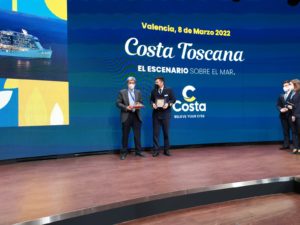
The president of the Port Authority of Valencia (PAV), Aurelio Martinez has delivered the traditional “socarrat” to the captain of the ship Pietro Sinisi.
The Costa Toscana cruise ship, the new flagship of Costa Cruceros, powered by liquefied natural gas (LNG), arrived this morning at the docks of the Port of Valencia. This is the first call of this ship in Cap i Casal, which until the end of the year will make 58 berths at the docks of the Port of Valencia. The president of the Port Authority of Valencia (APV), Aurelio Martínez, presented the traditional “socarrat” to the captain of the Costa Toscana, Pietro Sinisi, in a ceremony which was also attended by the president of Costa Cruceros, Mario Zanetti, and the regional secretary for Tourism of the Generalitat Valenciana, Francesc Colomer.
Aurelio Martínez stressed that these models of ships that Costa Cruceros is committed to “are in line with the objective of decarbonising the port of Valencia and the port community. The company’s commitment to the environment and the fight against climate change is embodied in this type of project, an example of the maritime industry’s commitment to the objectives of the European green pact”.
LNG is natural gas that has been processed to be transported in liquid form. One of the advantages of this fuel, which is normally in a gaseous state, is that its volume is reduced, making it easier to transport. It is also the most efficient alternative for achieving decarbonisation in maritime transport. Compared to other traditional fuels, LNG eliminates 100% of sulphur oxides (SOX), 85% of nitrogen oxides (NOX) and 20% of CO2 emissions. This makes it possible for a sector such as the maritime sector to move towards environmental sustainability, improving performance both at sea and in port calls.
Costa Toscana’s commitment to the environment goes beyond the use of LNG. The ship is an itinerant “smart city” with advanced circular economy solutions with the aim of taking a further step towards environmental sustainability. To this end, they cover all the ship’s daily water needs by desalinating seawater. In addition, they reduce energy consumption to a minimum thanks to an intelligent system that improves efficiency. The lifts have practically zero consumption and recycle 100% of the energy, the kitchens are low impact, with ovens equipped with a controlled ventilation system.
Another of the Costa Toscana’s commitments is to the recycling of materials such as plastic, paper, glass and aluminium, with 100% selective collection. In the case of food, they have designed more than 500 recipes that favour seasonality, proximity and the nutritional value of the food. Work is also being done to raise awareness among both passengers and crew members about responsible consumption. Together with the 4GOODFOOD programme, they have managed to reduce food waste by 35% and hundreds of thousands of meals have been donated to disadvantaged people.
Itinerary on board Costa Toscana
The first cruise departs from Barcelona on 7 March and from Valencia on 8 March. The one-week itinerary takes in the cities of Palermo, Civitavecchia/Rome, Marseille, Barcelona and Valencia. Specifically, until the end of this year it will make 58 stopovers in Valencia. During the summer season, it will change Barcelona for Ibiza and will call at Savona, Civitavecchia/Rome, Naples, Ibiza, Valencia and Marseilles. And in the autumn season, Palma de Mallorca will replace Ibiza

